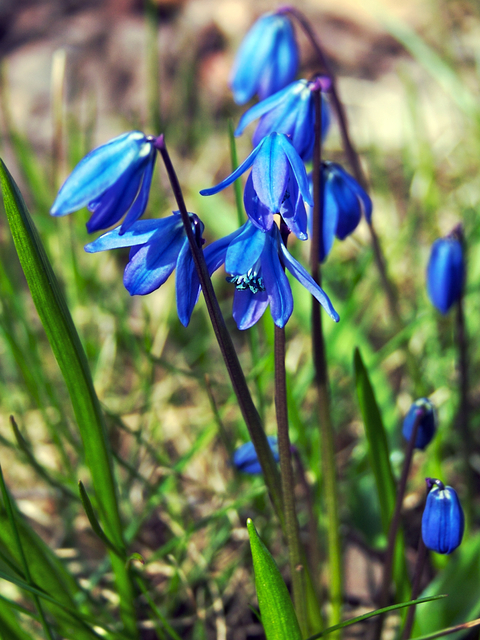Quick facts
Squill (Scilla siberica) is a popular landscape plant that can be invasive.
- Squill readily spreads itself and is hardy and cold tolerant.
- Often found in wooded areas in early spring, emerging and blooming right after snow melts.
- Please report this species so we can better understand its distribution in the wild.
Squill is a spring ephemeral, emerging early and blooming right after the snow melts. It is a hardy plant and cold tolerant, and it has historically been a favorite of gardeners for its striking blue flowers. Unfortunately, squill naturalizes quite easily, spreading quickly by self-seeding and bulb offshoots. Because of its rapid spread and condition tolerance, this non-native species has the potential to become an invasive plant.
How to identify squill
- Stem: One or more arching, hairless flower stalks form from the center of the rosette.
- Leaves: 5-inch-long, grass-like, hairless leaves emerge from one point.
- Flowers: 1-inch-wide, bell-shaped flowers occur singly or as a group of 2-3 at the top of a slim stem. Consists of six flaring, blue petals with a dark blue center strip and six white stamens with blue tips. Flower color may vary with variety and include white, pink or violet.
- Seeds: Seed capsules are green and bumpy, and turn brown as they mature and split to produce dark reddish-brown seeds.
- Roots: Bulb
Common look-alikes
- Crocus (Crocus vernus) is one of the first plants to emerge and flower in the spring. This non-native bulb is commonly planted in yards and gardens. Flowers have 6 petals, are 2-3 inches across, and range from white to purple.
- Glory of the snow (Chionodoxa luciliae) is another very early blooming non-native bulbs with 6 thin flower petals that are purple with white near the center.
Reporting and controlling squill
Please report squill that has escaped, not squill that's in a tended garden. As with all non-native species found in unmanaged areas, report findings of this species using one of the following methods:
- Use the Great Lakes Early Detection Network (GLEDN) free mobile app (preferred).
- Report using the EDDMapS Midwest web-based mapping system for documenting invasive species.
Management
- Mow after bloom to remove seed heads and reduce spreading by seed.
- Thin by digging after bloom before seed set and composting plants.
- Monitoring the area each spring is important for continued control.
- There are no special considerations disposing of this plant.
Reviewed in 2021


